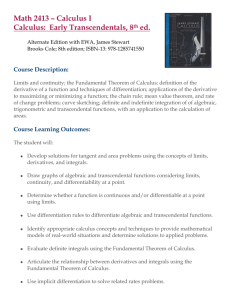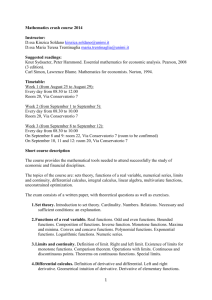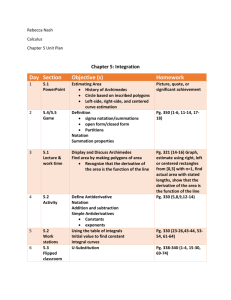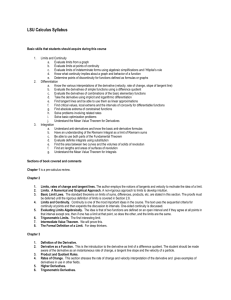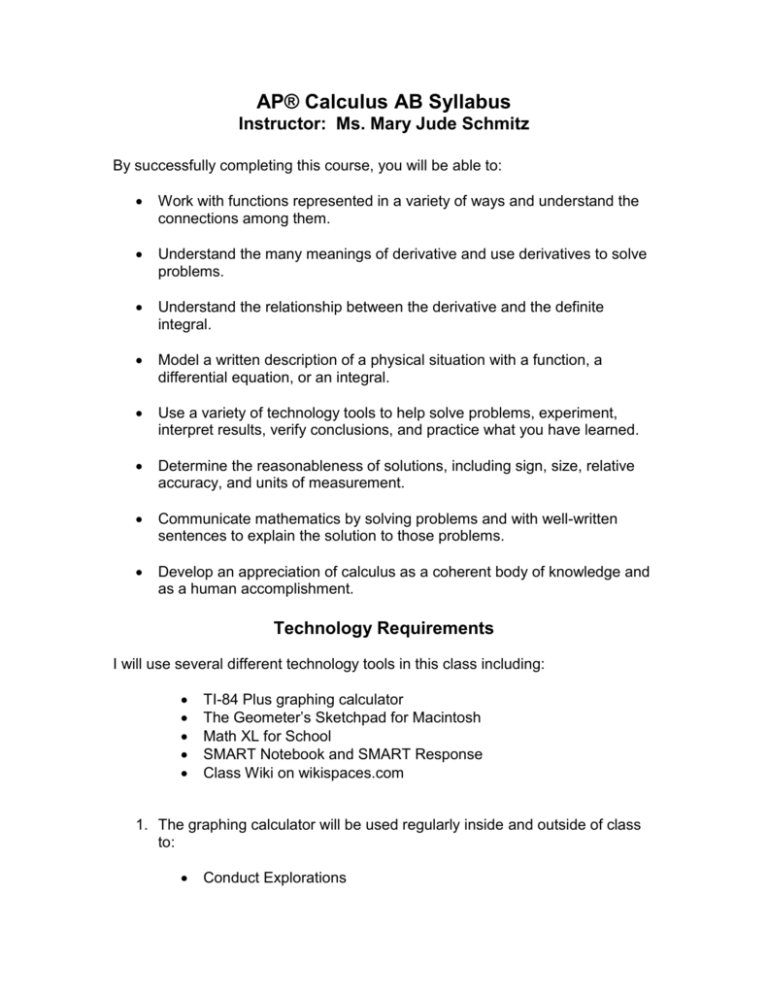
AP® Calculus AB Syllabus
Instructor: Ms. Mary Jude Schmitz
By successfully completing this course, you will be able to:
Work with functions represented in a variety of ways and understand the
connections among them.
Understand the many meanings of derivative and use derivatives to solve
problems.
Understand the relationship between the derivative and the definite
integral.
Model a written description of a physical situation with a function, a
differential equation, or an integral.
Use a variety of technology tools to help solve problems, experiment,
interpret results, verify conclusions, and practice what you have learned.
Determine the reasonableness of solutions, including sign, size, relative
accuracy, and units of measurement.
Communicate mathematics by solving problems and with well-written
sentences to explain the solution to those problems.
Develop an appreciation of calculus as a coherent body of knowledge and
as a human accomplishment.
Technology Requirements
I will use several different technology tools in this class including:
TI-84 Plus graphing calculator
The Geometer’s Sketchpad for Macintosh
Math XL for School
SMART Notebook and SMART Response
Class Wiki on wikispaces.com
1. The graphing calculator will be used regularly inside and outside of class
to:
Conduct Explorations
Graph Functions within arbitrary windows
Solve equations numerically
Analyze and interpret results
Justify and explain results of graphs and equations
2. The Geometer’s Sketchpad will be used on your laptop along with Paul A.
Foerster’s Calculus Explorations in order to explore and discover calculus
relationships.
3. Math XL for School works with the textbook by Finney, Demana, Waits,
and Kennedy (Calculus Graphical, Numerical, Algebraic Media Update) to
help practice and get immediate feedback for concepts learned in class.
4. SMART Notebook outlines of each days lessons will be available for
download onto your laptop so you can take notes right on your laptop or
print out and write notes on the outlines. SMART response questions will
be worked into those outlines and SMART response quizzes will be given
for homework review.
5. The class wiki will be used for a calendar, homework assignments,
discussion questions and review.
A Brief Description
Current mathematical education emphasizes a “Rule of Four.” There are a
variety of ways to approach and solve problems. The four branches of the
problem-solving tree of mathematics are:
Numerical analysis (where data points are known but not an equation)
Graphical analysis (where graph is known, but not an equation)
Analytic/algebraic analysis (traditional equation and variable manipulation)
Verbal/written methods of representing problems (classic story problems
as well as written justification of one’s thinking in solving a problem)
Below is an outline of topics along with a tentative timeline. Assessments are
given at the end of each unit as well as intermittently during each unit. Semester
finals are also given.
Unit 1: Functions, Limits and Continuity (4-5 weeks)
A. Functions and Graphs
1. Functions
2. Domains and Ranges
3. Viewing and Interpreting Graphs
4.
5.
6.
7.
Even Functions and Odd Functions
Functions Defined in Pieces
Absolute Value Functions
Composite Functions
B. Exponential Functions
1. Exponential Growth
2. Exponential Decay
3. Applications
4. The number e
C. Functions and Logarithms
1. One-to-One Functions
2. Inverses and Finding Inverses
3. Logarithmic Functions
4. Properties of Logarithms
5. Applications
D. Trigonometric Functions
1. Radian Measure
2. Graphs of Trigonometric Functions
3. Periodicity
4. Even and Odd Trigonometric Functions
5. Transformations of Trigonometric Graphs
6. Inverse Trigonometric Functions
E. Rates of Change and Limits
1. Average and Instantaneous Speed
2. Definition of Limit
3. Properties of Limits
4. One-sided and Two sided Limits
5. Sandwich Theorem
F. Limits Involving Infinity
1. Finite Limits as x approaches infinity
2. Infinite Limits as x approaches a
3. End Behavior Models
4. “Seeing” Limits as x approaches infinity
G. Continuity
1. Continuity at a Point
2. Continuous Functions
3. Algebraic Combinations
4. Composites
5. Intermediate Value Theorem for Continuous Functions
H. Rates of Change and Tangent Lines
1. Average Rates of Change
2. Tangent to a Curve
3. Slope of a Curve
4. Normal to a Curve
5. Speed Revisited
Unit 2: The Derivative (5-6 weeks)
A. Derivative of a Function
1. Definition of a Derivative
2. Notation
3. Relationship Between the graphs of f and f’
4. Graphing the Derivative from Data
5. One-sided Derivatives
B. Differentiability
1. How f’(a) Might Fail to Exist
2. Differentiability Implies Local Linearity
3. Derivatives on a Calculator
4. Differentiability Implies Continuity
5. Intermediate Value Theorem for Derivatives
C. Rules for Differentiation
1. Positive Integer Powers, Multiples, Sums and Differences
2. Products and Quotients
3. Negative Integer Powers of x
4. Second and Higher Order Derivatives
D. Velocity and Other Rates of Change
1. Instantaneous Rates of Change
2. Motion along a Line
3. Sensitivity to Change
4. Derivative in Ecomomics
E. Derivatives of Trigonometric Functions
1. Derivative of the Sine Function
2. Derivative of the Cosine Function
3. Simple Harmonic Motion
4. Jerk
5. Derivatives of Other Basic Trigonometric Functions
F. Chain Rule
1. Derivative of a composite Function
2. “Outside-Inside” Rule
3. Repeated Use of the Chain Rule
4. Power Chain Rule
G. Implicit Differentiation
1. Implicitly Defined Functions
2. Lenses, Tangents, and Normal Lines
3. Derivatives of Higher Order
4. Rational Powers of Differentiable Functions
H. Derivatives of Inverse Trigonometric Functions
1. Derivatives of Inverse Functions
2. Derivative of the Arcsine
3. Derivative of the Arctangent
4. Derivative of the Arcsecant
5. Derivatives of the other 3
I. Derivatives of Exponential and Logarithmic Functions
1. Derivative of ex
2. Derivative of ax
3. Derivative of ln x
4. Derivative of logax
5. Power Rule for Arbitrary Real Powers
Unit 3: Applications of the Derivative (5-6 weeks)
A. Extreme Value Functions
1. Absolute Extreme Values
2. Local Extreme Values
3. Finding Extreme Values
B. Mean Value Theorem
1. Mean Value Theorem
2. Physical Interpretation
3. Increasing and Decreasing Functions
4. Other Consequences
C. Connecting f’ and f” with the Graph of f
1. First Derivative Test for Local Extrema
2. Concavity
3. Points of Inflection
4. Second Derivative Test for Local Extrema
5. Learning about Functions from Derivatives
D. Modeling and Optimization
1. Examples from Mathematics
2. Examples from Business and Industry
3. Examples from Economics
4. Modeling Discrete Phenomena with different Differentiable
Functions
E. Linearization and Newton’s Method
1. Linear Approximation
2. Newton’s Method
3. Differentials
4. Estimating Change with Differentials
5. Absolute, Relative, and Percentage Change
6. Sensitivity to Change
F. Related Rates
1. Related Rate Equations
2. Solution Strategy
3. Simulating Related Motion
Unit 4: The Definite Integral (4-5 weeks)
A. Estimating with Finite Sums
1. Distance Traveled
2. Rectangular Approximation Method
3. Volume of a Sphere
4. Cardiac Output
B. Definite Integrals
1. Riemann Sums
2. Terminology and Notation of Integration
3. Definite Integral and Area
4. Constant Functions
5. Integrals on a Calculator
6. Discontinuous Integrable Functions
C. Definite Integrals and Antiderivatives
1. Properties of Definite Integrals
2. Average Value of a Function
3. Mean Value Theorem for Definite Integrals
4. Connecting Differential and Integral Calculus
D. Fundamental Theorem of Calculus
1. Fundamental Theorem Part 1
2. Fundamental Theorem Part 2
3. Area Connection
4. Analyzing Antiderivatives Graphically
E. Trapezoidal Rule
1. Trapezoidal Approximations
2. Other Algorithms
3. Error Analysis
Unit 5: Differential Equations and Mathematical Modeling (4
weeks)
A. Slope Fields
1. Differential Equations
2. Slope Fields
B. Antidifferentiation by Substitution
1. Indefinite Integrals
2. Leibniz Notation and Antiderivatives
3. Substitution in Indefinite Integrals
4. Substitution in Definite Integrals
C. Antidifferentiation by Parts
1. Product Rule in Integral Form
2. Solving for the Unknown Integral
3. Tabular Integration
4. Inverse Trigonometric and Logarithmic Functions
D. Exponential Growth and Decay
1. Separable Differential Equations
2. Law of Exponential Change
3. Continuously Compounded Interest
4. Radioactivity
5. Modeling Growth with Other Bases
6. Newton’s Law of Cooling
E. Logistic Growth
1. How Populations Grow
2. Partial Fractions
3. The Logistic Differential Equation
4. Logistic Growth Models
Unit 6: Applications of Definite Integrals (4 weeks)
A. Integral as a Net Change
1. Linear Motion Revisited
2. General Strategy
3. Consumption Over Time
4. Net Change from Data
5. Work
B. Areas in a Plane
1. Area Between Curves
2.
3.
4.
5.
C. Volumes
1.
2.
3.
4.
5.
Area Enclosed by Intersecting Curves
Boundaries with Changing Functions
Integrating with Respect to y
Saving Time with Geometry Formulas
Volume as an Integral
Square Cross Sections
Circular Cross Sections
Cylindrical Shells
Other Cross Sections
D. Applications from Science and Statistics
1. Work Revisited
2. Fluid Force and Fluid Pressure
3. Normal Probabilities
Unit 7: Review/Test Preparation (5-6 weeks)
A. Multiple-choice practice (review problems from supplemental materials
with the textbook and other review books I have purchased.)
1. Test taking strategies are emphasized
2. Individual and group practice both used
3. Student Response System (clickers) used for immediate
feedback
B. Free-Response practice
1. Rubrics are reviewed so students see the need for complete
answers
2. Students collaborate to formulate team responses (games and
other methods used)
3. Individually written responses are crafted. Attention to full
explanations is emphasized.
Unit 8: After the Exam…
A. Projects designed to incorporate this year’s learning in applied ways
Textbook and other Supplemental Materials
Finney, Demana, Waits, and Kennedy. Calculus-Graphical, Numerical,
Algebraic. Third Edition Media Update. Pearson Prentice Hall, 2010
Paul A. Foerster. Calculus Exporations. Key Curriculum Press 1998
Mark Howell and Martha Montgomery. Be Prepared for the AP® Calculus Exam.
Skylight Publishing 2005
My hope for this class is that you will learn through explorations how to discover
calculus concepts for yourself and apply these to several different areas of our
world. Hopefully, through calculus you will understand the universe a little better
and be able to predict or explain much of what goes on around you. Math is
much more than numbers and algorithms and it is my goal, through this class,
that you will have a much better appreciation for math than when we started.






